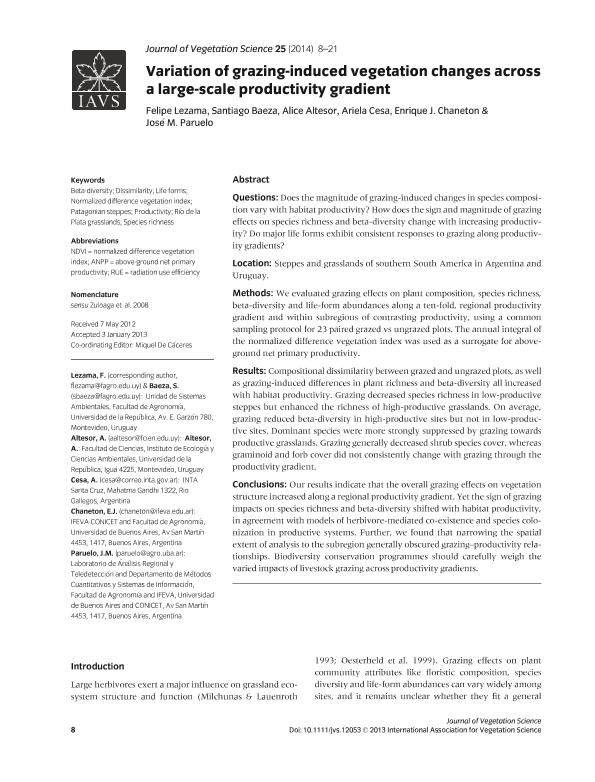Artículo
Variation of grazing-induced vegetation changes across a large-scale productivity gradient
Lezama, Felipe; Baeza, Santiago; Altesor, Alice; Cesa, Ariela; Chaneton, Enrique Jose ; Paruelo, José
; Paruelo, José
 ; Paruelo, José
; Paruelo, José
Fecha de publicación:
01/2014
Editorial:
Wiley
Revista:
Journal of Vegetation Science
ISSN:
1100-9233
Idioma:
Inglés
Tipo de recurso:
Artículo publicado
Clasificación temática:
Resumen
Questions:
Does the magnitude of grazing-induced changes in species composition vary with habitat productivity? How does the sign and magnitude of grazing effects on species richness and beta-diversity change with increasing productivity? Do major life forms exhibit consistent responses to grazing along productivity gradients?
Location:
Steppes and grasslands of southern South America in Argentina and Uruguay.
Methods:
We evaluated grazing effects on plant composition, species richness, beta-diversity and life-form abundances along a ten-fold, regional productivity gradient and within subregions of contrasting productivity, using a common sampling protocol for 23 paired grazed vs ungrazed plots. The annual integral of the normalized difference vegetation index was used as a surrogate for above-ground net primary productivity.
Results:
Compositional dissimilarity between grazed and ungrazed plots, as well as grazing-induced differences in plant richness and beta-diversity all increased with habitat productivity. Grazing decreased species richness in low-productive steppes but enhanced the richness of high-productive grasslands. On average, grazing reduced beta-diversity in high-productive sites but not in low-productive sites. Dominant species were more strongly suppressed by grazing towards productive grasslands. Grazing generally decreased shrub species cover, whereas graminoid and forb cover did not consistently change with grazing through the productivity gradient.
Conclusions:
Our results indicate that the overall grazing effects on vegetation structure increased along a regional productivity gradient. Yet the sign of grazing impacts on species richness and beta-diversity shifted with habitat productivity, in agreement with models of herbivore-mediated co-existence and species colonization in productive systems. Further, we found that narrowing the spatial extent of analysis to the subregion generally obscured grazing–productivity relationships. Biodiversity conservation programmes should carefully weigh the varied impacts of livestock grazing across productivity gradients
Archivos asociados
Licencia
Identificadores
Colecciones
Articulos(IFEVA)
Articulos de INST.D/INV.FISIOLOGICAS Y ECO.VINCULADAS A L/AGRIC
Articulos de INST.D/INV.FISIOLOGICAS Y ECO.VINCULADAS A L/AGRIC
Articulos(OCA PQUE. CENTENARIO)
Articulos de OFICINA DE COORDINACION ADMINISTRATIVA PQUE. CENTENARIO
Articulos de OFICINA DE COORDINACION ADMINISTRATIVA PQUE. CENTENARIO
Citación
Lezama, Felipe; Baeza, Santiago; Altesor, Alice; Cesa, Ariela; Chaneton, Enrique Jose; et al.; Variation of grazing-induced vegetation changes across a large-scale productivity gradient; Wiley; Journal of Vegetation Science; 25; 1-2014; 8-21
Compartir
Altmétricas



